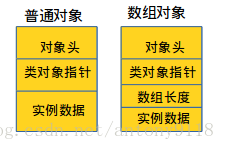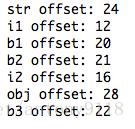两种计算Java对象大小的方法
1 基础知识
普通对象的结构如下,按64位机器的长度计算
1. 对象头(_mark), 8个字节
2. Oop指针,如果是32G内存以下的,默认开启对象指针压缩,4个字节
3. 数据区
4. Padding(内存对齐),按照8的倍数对齐
数组对象结构是
1. 对象头(_mark), 8个字节
2. Oop指针,如果是32G内存以下的,默认开启对象指针压缩,4个字节
3. 数组长度,4个字节
4. 数据区
5. Padding(内存对齐),按照8的倍数对齐

清楚了对象在内存的基本布局后,咱们说两种计算Java对象大小的方法
- 通过java.lang.instrument.Instrumentation的getObjectSize(obj)直接获取对象的大小
- 通过sun.misc.Unsafe对象的objectFieldOffset(field)等方法结合反射来计算对象的大小
2 instrument的getObjectSize(obj)
先讲讲java.lang.instrument.Instrumentation.getObjectSize()的方式,这种方法得到的是Shallow Size,即遇到引用时,只计算引用的长度,不计算所引用的对象的实际大小。如果要计算所引用对象的实际大小,可以通过递归的方式去计算。
java.lang.instrument.Instrumentation的实例必须通过指定javaagent的方式才能获得,具体的步骤如下:
1. 定义一个类,提供一个premain方法: public static void premain(String agentArgs, Instrumentation instP)
2. 创建META-INF/MANIFEST.MF文件,内容是指定PreMain的类是哪个: Premain-Class: sizeof.ObjectShallowSize
3. 把这个类打成jar,然后用java -javaagent XXXX.jar XXX.main的方式执行
下面先定义一个类来获得java.lang.instrument.Instrumentation的实例,并提供了一个static的sizeOf方法对外提供Instrumentation的能力
package sizeof; import java.lang.instrument.Instrumentation; public class ObjectShallowSize { private static Instrumentation inst; public static void premain(String agentArgs, Instrumentation instP){ inst = instP; } public static long sizeOf(Object obj){ return inst.getObjectSize(obj); } }
定义META-INF/MANIFEST.MF文件
Premain-Class: sizeof.ObjectShallowSize
打成jar包
cd 编译后的类和META-INF文件夹所在目录
jar cvfm java-agent-sizeof.jar META-INF/MANIFEST.MF
准备好了这个jar之后,我们可以写测试类来测试Instrumentation的getObjectSize方法了。在这之前我们先来看对象在内存中是按照什么顺序排列的
有如下这个类,字段的定义按如下顺序
private static class ObjectA { String str; // 4 int i1; // 4 byte b1; // 1 byte b2; // 1 int i2; // 4 ObjectB obj; //4 byte b3; // 1 }
按照我们之前说的方法来计算一下这个对象所占大小,注意按8对齐
8(_mark) + 4(oop指针) + 4(str) + 4(i1) + 1(b1) + 1(b2) + 2(padding) + 4(i2) + 4(obj) + 1(b3) + 7(padding) = 40 ?
但事实上是这样的吗? 我们来用Instrumentation的getObjectSize来计算一下先:
package test; import sizeof.ObjectShallowSize; public class SizeofWithInstrumetation { private static class ObjectA { String str; // 4 int i1; // 4 byte b1; // 1 byte b2; // 1 int i2; // 4 ObjectB obj; //4 byte b3; // 1 } private static class ObjectB { } public static void main(String[] args){ System.out.println(ObjectShallowSize.sizeOf(new ObjectA())); } }
得到的结果是32!不是会按8对齐吗,b3之前的数据加起来已经是32了,多了1个b3,为33,应该对齐到40才对啊。事实上,HotSpot创建的对象的字段会先按照给定顺序排列一下,默认的顺序如下,从长到短排列,引用排最后: long/double –> int/float –> short/char –> byte/boolean –> Reference
这个顺序可以使用JVM参数: -XX:FieldsAllocationSylte=0(默认是1)来改变。
我们使用sun.misc.Unsafe对象的objectFieldOffset方法来验证一下:
Field[] fields = ObjectA.class.getDeclaredFields(); for(Field f: fields){ System.out.println(f.getName() + " offset: " +unsafe.objectFieldOffset(f)); }

可以看到确实是按照从长到短,引用排最后的方式在内存中排列的。按照这种方法我们来重新计算下ObjectA创建的对象的长度:
8(_mark) + 4(oop指针) + 4(i1) + + 4(i2) + 1(b1) + 1(b2) + 1(b3) + 1(padding) + 4(str) + 4(obj) = 32
得到的结果和java.lang.instrument.Instrumentation.getObjectSize()的结果是一样的,证明我们的计算方式是正确的。
3 sun.misc.Unsafe的方式
下面说一下通过sun.misc.Unsafe对象的objectFieldOffset(field)等方法结合反射来计算对象的大小。基本的思路如下:
1. 通过反射获得一个类的Field
2. 通过Unsafe的objectFieldOffset()获得每个Field的offSet
3. 对Field按照offset排序,取得最大的offset,然后加上这个field的长度,再加上Padding对齐
上面三步就可以获得一个对象的Shallow size。可以进一步通过递归去计算所引用对象的大小,从而可以计算出一个对象所占用的实际大小。
如何获得Unsafe对象已经在这篇中聊聊序列化(二)使用sun.misc.Unsafe绕过new机制来创建Java对象说过了,可以通过反射的机制来获得.
Oop指针是4还是未压缩的8也可以通过unsafe.arrayIndexScale(Object[].class)来获得,这个方法返回一个引用所占用的长度
static { try { Field field = Unsafe.class.getDeclaredField("theUnsafe"); field.setAccessible(true); unsafe = (Unsafe) field.get(null); objectRefSize = unsafe.arrayIndexScale(Object[].class); } catch (Exception e) { throw new RuntimeException(e); } }
下面的源码摘自 http://java-performance.info/memory-introspection-using-sun-misc-unsafe-and-reflection/, 原文中的代码在计算对象大小的时候有问题,我做了微调,并加上了内存对齐的方法,这样计算出的结果和Instrumentation的getObjectSize方法是一样的。

package test; import java.util.ArrayList; import java.util.Collections; import java.util.Comparator; import java.util.List; /** * This class contains object info generated by ClassIntrospector tool */ public class ObjectInfo { /** Field name */ public final String name; /** Field type name */ public final String type; /** Field data formatted as string */ public final String contents; /** Field offset from the start of parent object */ public final int offset; /** Memory occupied by this field */ public final int length; /** Offset of the first cell in the array */ public final int arrayBase; /** Size of a cell in the array */ public final int arrayElementSize; /** Memory occupied by underlying array (shallow), if this is array type */ public final int arraySize; /** This object fields */ public final List<ObjectInfo> children; public ObjectInfo(String name, String type, String contents, int offset, int length, int arraySize, int arrayBase, int arrayElementSize) { this.name = name; this.type = type; this.contents = contents; this.offset = offset; this.length = length; this.arraySize = arraySize; this.arrayBase = arrayBase; this.arrayElementSize = arrayElementSize; children = new ArrayList<ObjectInfo>( 1 ); } public void addChild( final ObjectInfo info ) { if ( info != null ) children.add( info ); } /** * Get the full amount of memory occupied by a given object. This value may be slightly less than * an actual value because we don't worry about memory alignment - possible padding after the last object field. * * The result is equal to the last field offset + last field length + all array sizes + all child objects deep sizes * @return Deep object size */ public long getDeepSize() { //return length + arraySize + getUnderlyingSize( arraySize != 0 ); return addPaddingSize(arraySize + getUnderlyingSize( arraySize != 0 )); } long size = 0; private long getUnderlyingSize( final boolean isArray ) { //long size = 0; for ( final ObjectInfo child : children ) size += child.arraySize + child.getUnderlyingSize( child.arraySize != 0 ); if ( !isArray && !children.isEmpty() ){ int tempSize = children.get( children.size() - 1 ).offset + children.get( children.size() - 1 ).length; size += addPaddingSize(tempSize); } return size; } private static final class OffsetComparator implements Comparator<ObjectInfo> { @Override public int compare( final ObjectInfo o1, final ObjectInfo o2 ) { return o1.offset - o2.offset; //safe because offsets are small non-negative numbers } } //sort all children by their offset public void sort() { Collections.sort( children, new OffsetComparator() ); } @Override public String toString() { final StringBuilder sb = new StringBuilder(); toStringHelper( sb, 0 ); return sb.toString(); } private void toStringHelper( final StringBuilder sb, final int depth ) { depth( sb, depth ).append("name=").append( name ).append(", type=").append( type ) .append( ", contents=").append( contents ).append(", offset=").append( offset ) .append(", length=").append( length ); if ( arraySize > 0 ) { sb.append(", arrayBase=").append( arrayBase ); sb.append(", arrayElemSize=").append( arrayElementSize ); sb.append( ", arraySize=").append( arraySize ); } for ( final ObjectInfo child : children ) { sb.append( '\n' ); child.toStringHelper(sb, depth + 1); } } private StringBuilder depth( final StringBuilder sb, final int depth ) { for ( int i = 0; i < depth; ++i ) sb.append( "\t"); return sb; } private long addPaddingSize(long size){ if(size % 8 != 0){ return (size / 8 + 1) * 8; } return size; } } package test; import java.lang.reflect.Array; import java.lang.reflect.Field; import java.lang.reflect.Modifier; import java.util.ArrayList; import java.util.Arrays; import java.util.Collections; import java.util.HashMap; import java.util.IdentityHashMap; import java.util.List; import java.util.Map; import sun.misc.Unsafe; /** * This class could be used for any object contents/memory layout printing. */ public class ClassIntrospector { private static final Unsafe unsafe; /** Size of any Object reference */ private static final int objectRefSize; static { try { Field field = Unsafe.class.getDeclaredField("theUnsafe"); field.setAccessible(true); unsafe = (Unsafe) field.get(null); objectRefSize = unsafe.arrayIndexScale(Object[].class); } catch (Exception e) { throw new RuntimeException(e); } } /** Sizes of all primitive values */ private static final Map<Class, Integer> primitiveSizes; static { primitiveSizes = new HashMap<Class, Integer>(10); primitiveSizes.put(byte.class, 1); primitiveSizes.put(char.class, 2); primitiveSizes.put(int.class, 4); primitiveSizes.put(long.class, 8); primitiveSizes.put(float.class, 4); primitiveSizes.put(double.class, 8); primitiveSizes.put(boolean.class, 1); } /** * Get object information for any Java object. Do not pass primitives to * this method because they will boxed and the information you will get will * be related to a boxed version of your value. * * @param obj * Object to introspect * @return Object info * @throws IllegalAccessException */ public ObjectInfo introspect(final Object obj) throws IllegalAccessException { try { return introspect(obj, null); } finally { // clean visited cache before returning in order to make // this object reusable m_visited.clear(); } } // we need to keep track of already visited objects in order to support // cycles in the object graphs private IdentityHashMap<Object, Boolean> m_visited = new IdentityHashMap<Object, Boolean>( 100); private ObjectInfo introspect(final Object obj, final Field fld) throws IllegalAccessException { // use Field type only if the field contains null. In this case we will // at least know what's expected to be // stored in this field. Otherwise, if a field has interface type, we // won't see what's really stored in it. // Besides, we should be careful about primitives, because they are // passed as boxed values in this method // (first arg is object) - for them we should still rely on the field // type. boolean isPrimitive = fld != null && fld.getType().isPrimitive(); boolean isRecursive = false; // will be set to true if we have already // seen this object if (!isPrimitive) { if (m_visited.containsKey(obj)) isRecursive = true; m_visited.put(obj, true); } final Class type = (fld == null || (obj != null && !isPrimitive)) ? obj .getClass() : fld.getType(); int arraySize = 0; int baseOffset = 0; int indexScale = 0; if (type.isArray() && obj != null) { baseOffset = unsafe.arrayBaseOffset(type); indexScale = unsafe.arrayIndexScale(type); arraySize = baseOffset + indexScale * Array.getLength(obj); } final ObjectInfo root; if (fld == null) { root = new ObjectInfo("", type.getCanonicalName(), getContents(obj, type), 0, getShallowSize(type), arraySize, baseOffset, indexScale); } else { final int offset = (int) unsafe.objectFieldOffset(fld); root = new ObjectInfo(fld.getName(), type.getCanonicalName(), getContents(obj, type), offset, getShallowSize(type), arraySize, baseOffset, indexScale); } if (!isRecursive && obj != null) { if (isObjectArray(type)) { // introspect object arrays final Object[] ar = (Object[]) obj; for (final Object item : ar) if (item != null) root.addChild(introspect(item, null)); } else { for (final Field field : getAllFields(type)) { if ((field.getModifiers() & Modifier.STATIC) != 0) { continue; } field.setAccessible(true); root.addChild(introspect(field.get(obj), field)); } } } root.sort(); // sort by offset return root; } // get all fields for this class, including all superclasses fields private static List<Field> getAllFields(final Class type) { if (type.isPrimitive()) return Collections.emptyList(); Class cur = type; final List<Field> res = new ArrayList<Field>(10); while (true) { Collections.addAll(res, cur.getDeclaredFields()); if (cur == Object.class) break; cur = cur.getSuperclass(); } return res; } // check if it is an array of objects. I suspect there must be a more // API-friendly way to make this check. private static boolean isObjectArray(final Class type) { if (!type.isArray()) return false; if (type == byte[].class || type == boolean[].class || type == char[].class || type == short[].class || type == int[].class || type == long[].class || type == float[].class || type == double[].class) return false; return true; } // advanced toString logic private static String getContents(final Object val, final Class type) { if (val == null) return "null"; if (type.isArray()) { if (type == byte[].class) return Arrays.toString((byte[]) val); else if (type == boolean[].class) return Arrays.toString((boolean[]) val); else if (type == char[].class) return Arrays.toString((char[]) val); else if (type == short[].class) return Arrays.toString((short[]) val); else if (type == int[].class) return Arrays.toString((int[]) val); else if (type == long[].class) return Arrays.toString((long[]) val); else if (type == float[].class) return Arrays.toString((float[]) val); else if (type == double[].class) return Arrays.toString((double[]) val); else return Arrays.toString((Object[]) val); } return val.toString(); } // obtain a shallow size of a field of given class (primitive or object // reference size) private static int getShallowSize(final Class type) { if (type.isPrimitive()) { final Integer res = primitiveSizes.get(type); return res != null ? res : 0; } else return objectRefSize; } }
先一个测试类来验证一下Unsafe的方式计算出的结果
public class ClassIntrospectorTest { public static void main(String[] args) throws IllegalAccessException { final ClassIntrospector ci = new ClassIntrospector(); ObjectInfo res; res = ci.introspect( new ObjectA() ); System.out.println( res.getDeepSize() ); } private static class ObjectA { String str; // 4 int i1; // 4 byte b1; // 1 byte b2; // 1 int i2; // 4 ObjectB obj; //4 byte b3; // 1 } private static class ObjectB { } }
计算结果如下:
32
和我们之前计算结果是一致的,证明是正确的。
最后再来测试一下数组对象的长度。有两个类如下:
private static class ObjectC { ObjectD[] array = new ObjectD[2]; } private static class ObjectD { int value; }
它们在内存的大体分布如下图:

我们可以手工计算一下ObjectC obj = new ObjectC()的大小:
ObjectC的Shallow size = 8(_mark) + 4(oop指针) + 4(ObjectD[]引用) = 16
new ObjectD[2]数组的长度 = 8(_mark) + 4(oop指针) + 4(数组长度占4个字节) + 4(ObjectD[0]引用) + 4(ObjectD[1]引用) = 24
由于ObjectD[]数组没有指向具体的对象大小,所以我们手工计算的结果是16 + 24 = 40
使用Unsafe对象的方式来计算一下:
public static void main(String[] args) throws IllegalAccessException { final ClassIntrospector ci = new ClassIntrospector(); ObjectInfo res; res = ci.introspect( new ObjectC() ); System.out.println( res.getDeepSize() ); }
计算结果如下,和我们计算的结果是一致的,证明是正确的:
40
再给ObjectD[]数组指向具体的ObjectD对象,再测试一下结果:
public static void main(String[] args) throws IllegalAccessException { final ClassIntrospector ci = new ClassIntrospector(); ObjectInfo res; res = ci.introspect( new ObjectC() ); System.out.println( res.getDeepSize() ); } private static class ObjectC { ObjectD[] array = new ObjectD[2]; public ObjectC(){ array[0] = new ObjectD(); array[1] = new ObjectD(); } } private static class ObjectD { int value; }
我们可以手工计算一下ObjectC obj = new ObjectC()的大小:
ObjectC的Shallow size = 8(_mark) + 4(oop指针) + 4(ObjectD[]引用) = 16
new ObjectD[2]数组的长度 = 8(_mark) + 4(oop指针) + 4(数组长度占4个字节) + 4(ObjectD[0]引用) + 4(ObjectD[1]引用) = 24
ObjectD对象长度 = 8(_mark) + 4(oop指针) + 4(value) = 16
所以ObjectC实际占用的空间 = 16 + 24 + 2 * 16 = 72
使用Unsafe的方式计算的结果也是72,和我们手工计算的方式一致。




